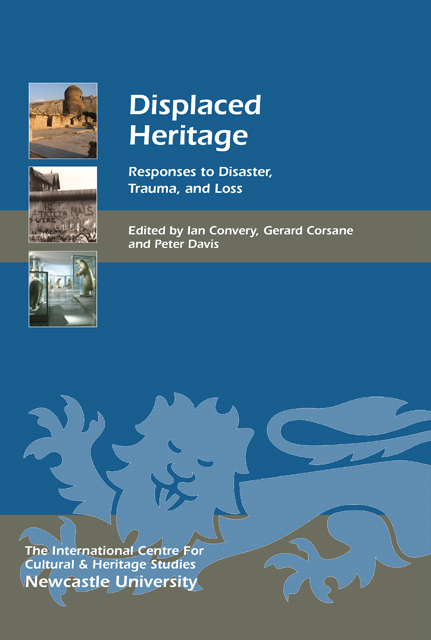Book contents
- Frontmatter
- Contents
- List of Illustrations
- Acknowledgments
- List of Abbreviations
- Preface
- Introduction
- Displaced Heritage: Histories and Tourism
- Displaced Heritage: Trauma, Confinement and Loss
- Displaced Heritage: Lived Realities, Local Experiences
- Displaced Natural Heritage
- Endpiece
- List of Contributors
- Index
- Heritage Matters
11 - Animating the Other Side: Animated Documentary as a Communication Tool for Exploring Displacement and Reunifi cation in Germany
Published online by Cambridge University Press: 24 February 2023
- Frontmatter
- Contents
- List of Illustrations
- Acknowledgments
- List of Abbreviations
- Preface
- Introduction
- Displaced Heritage: Histories and Tourism
- Displaced Heritage: Trauma, Confinement and Loss
- Displaced Heritage: Lived Realities, Local Experiences
- Displaced Natural Heritage
- Endpiece
- List of Contributors
- Index
- Heritage Matters
Summary
Introduction
In 2007, I completed my animated documentary, Die Andere Seite (The Other Side), which features oral history recordings of former West and East Berliners describing their memories of life in Germany before and after the fall of the Berlin Wall. The film emphasises personal perspectives of displacement and reunification from both sides of the divide. Participants tell of their curiosity about what they thought lay on ‘the other side’ and then describe their feelings and reactions on visiting for the first time, once the Wall was opened. One of the film’s main aims was to create a document of life in a divided Germany, in order to preserve for future generations personal experiences of post-World War II Germany, using interviews from participants who were born after the erection of the Wall.
This chapter will look at how animation is used to communicate personal experiences of division and reunification in Germany. It will focus on Die Andere Seite’s use of an animation device known as ‘metamorphosis’ to visually represent memories associated with reunification after division, and how communities were affected by the changes that resulted. The chapter also explores the use of space as a visual means to communicate change and transition.
Project Background
The making of this film has personal significance for me. As a child, I lived in West Berlin from 1986 to 1987 after my mother decided to relocate the family from the UK to be with my stepfather, who at the time was serving with the British army stationed at Spandau. We lived in a typical Berlin apartment outside of the army barracks and I went to a German-speaking Grundschule (primary school). On days out, we would often visit the tourist sites of West Berlin, including Checkpoint Charlie, which back then, before the Wall came down, was quite different to the shining, ordered place of remembrance constructed there today. My lasting impression of Checkpoint Charlie and that section of the Wall was that it seemed to be an area in the heart of the city that had been deserted. It was tensely quiet; the personnel moved more slowly and deliberately while on the other side of the street West Berliners would be busy about their daily business. I remember the crumbling concrete pavement and weeds growing out of the cracks.
- Type
- Chapter
- Information
- Displaced HeritageResponses to Disaster, Trauma, and Loss, pp. 121 - 128Publisher: Boydell & BrewerPrint publication year: 2014
- 1
- Cited by



